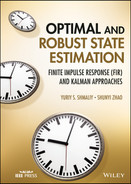Preface
The state estimation approach arose from the need to know the internal state of a real system, given that the input and output measurements are known. The corresponding structure is called a state estimator, and in control theory it is also called a state observer. In signal processing, the problem is related to the process state and its transition from one point to another. In contrast to parameter estimation theory, which deals with the estimation of the parameters of the fitting function, the state estimation approach is more suitable for engineering applications and the development of end‐to‐end algorithms.
Knowing the system state helps to solve many engineering problems. In systems, the state usually cannot be observed directly, but its indirect observation can be provided by way of the system outputs. In control, it is used to stabilize a system via state feedback. In signal processing, the direct, inverse, and identification problems are solved by applying state estimators (filters, smoothers, and predictors) to linear and nonlinear processes. In biomedical applications, state estimators facilitate extracting required process features.
The most general state estimator is a batch estimator, which requires data and input over a time horizon and has either infinite impulse response (IIR) or finite impulse response (FIR). Starting with the seminal works of Kalman, recursive state estimates have found an enormous number of applications. However, since recursions are mostly available for white noise, they are less accurate when noise is not white. The advantage is that recursions are computationally easy. But, unlike in Kalman's days, the computational complexity is no longer an issue for modern computers and microprocessors, and interest in batch optimal and robust estimators is growing.
To immediately acquaint the reader with the FIR approach, suppose that discrete measurements on a finite horizon are collected in the vector ![]() and the gain matrix
and the gain matrix ![]() , which contains the impulse response values, is defined in some sense (optimal or robust). Then the discrete convolution‐based batch FIR estimate
, which contains the impulse response values, is defined in some sense (optimal or robust). Then the discrete convolution‐based batch FIR estimate ![]() , which can be easily computed recursively, will have three advantages over Kalman recursions:
, which can be easily computed recursively, will have three advantages over Kalman recursions:
- Bounded input bounded output stability, which means there is no feedback and additional constraints to ensure stability and avoid divergence.
- Better accuracy in colored noise due to the ability to work with full block error matrices; recursive forms require such matrices to be diagonal.
- Higher robustness as uncertainties beyond the averaging horizon are not projected onto the current estimate.
This book is the first systematic investigation and analysis of batch state estimators and recursive forms. To elucidate the theory of optimal and robust FIR state estimators in continuous and discrete time, the book is organized as follows. Chapter 1 introduces the reader to the state estimation approach, discusses the properties of FIR state estimators, provides a brief historical overview, and observes the most noticeable works on the topic. Chapter 2 gives the basics of probability and stochastic processes. Chapter 3 discusses the available linear and nonlinear state estimators. Chapter 4 deals with optimal FIR filtering and considers a posteriori and a priori optimal, optimal unbiased, ML, and limited memory batch and recursive algorithms. Chapter 5 solves the ![]() ‐lag FIR smoothing problem. Chapter 6 presents an unbiased FIR state estimator. Chapter 7 introduces the receding horizon (RH) FIR state estimation approach. Chapter 8 develops the theory of FIR state estimation under disturbances and Chapter 9 for uncertain systems. Chapter 10 lists several additional topics in FIR state estimation. Chapter 11 provides several applications, where the FIR state estimators are used effectively. The remainder of the book is built with Appendix A, which presents matrix forms and relationships; Appendix B, which introduces the norms; and Appendix C, which contains Matlab‐based codes of FIR state estimators.
‐lag FIR smoothing problem. Chapter 6 presents an unbiased FIR state estimator. Chapter 7 introduces the receding horizon (RH) FIR state estimation approach. Chapter 8 develops the theory of FIR state estimation under disturbances and Chapter 9 for uncertain systems. Chapter 10 lists several additional topics in FIR state estimation. Chapter 11 provides several applications, where the FIR state estimators are used effectively. The remainder of the book is built with Appendix A, which presents matrix forms and relationships; Appendix B, which introduces the norms; and Appendix C, which contains Matlab‐based codes of FIR state estimators.
The authors appreciate the collaboration with Prof. Choon Ki Ahn of Korea University, South Korea, with whom several results were co‐authored. Yuriy Shmaliy appreciates the collaboration with Prof. Dan Simon of Cleveland University, Prof. Wojciech Pieczynski of Institut Polytechnique de Paris (Telecom SudParis), and Dr. Yuan Xu of University of Jinan, China, as well as the support of Prof. Oscar Ibarra‐Manzano and Prof. José Andrade‐Lucio of Universidad de Guanajuato, and contributions of his former and present Ph.D. and M.D. students Dr. Jorge Muñoz‐Minjares, Dr. Miguel Vázquez‐Olguín, Dr. Carlos Lastre‐Dominguez, Sandra Márquez‐Figueroa, Karen Uribe‐Murcia, Jorge Ortega‐Contreras, Eli Pale‐Ramon, and Juan José López Solórzano to the development of FIR state estimators for various signal processing and control areas. Shunyi Zhao appreciates the collaboration and support of Prof. Fei Liu of the Jiangnan University, China, and Prof. Biao Huang of the University of Alberta, Canada.
Yuriy S. Shmaliy
Shunyi Zhao
